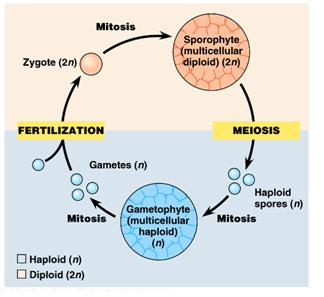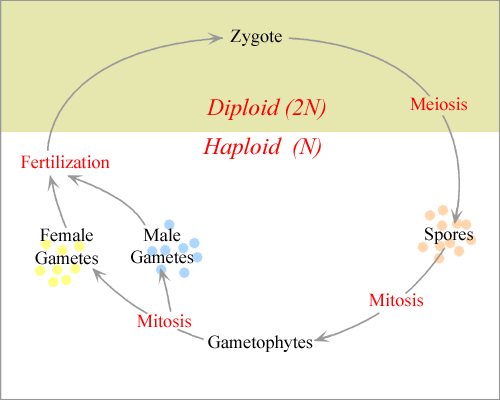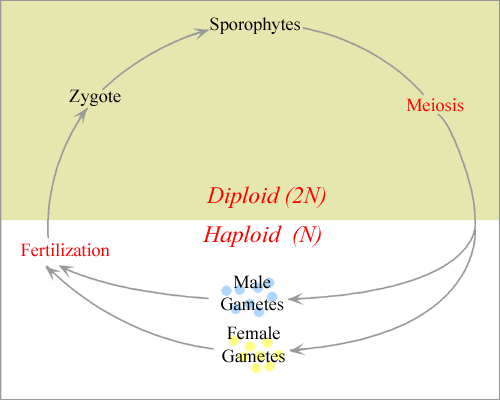A plant life cycle refers to the complete series of events from the formation of a zygote, its development into a mature plant, to the production of gametes by the plant to form the next generation. It includes all the life processes of the plant- growth, development, and reproduction.
Alternation of generation is also known as metagenesis or heterogenesis. In simple terms, it refers to the alternation of sexual and asexual phases in the life cycle of an organism. The sexual phase is called gametophyte generation and the asexual phase is called sporophyte generation.
Alternation Of Generations


The sexual phase (gametophyte) produces gametes (sex cells). They are haploid (n). They have only a single set of chromosome in the nucleus. The asexual phase (sporophyte) produces spores. They are diploid (2n). They have two sets of chromosomes in the nucleus.
Based on the duration of each phases in the life cycle, three different types of life cycles are identified:
- Haplontic: Gametophyte is dominant.
- Diplontic: Sporophyte is dominanat.
- Haplo–diplontic: Both sporophyte and gametophyte are independent of each other.
Haplontic Life Cycle
The dominant photosynthetic free-living phase is the gametophyte generation. It produces haploid gametes. The sporophyte generation is very small, represented by the diploid zygote. Gametic fusion (syngamy) produces a diploid zygote. The Zygote undergoes meiotic divisions to form haploid spores. Spores divide mitotically to form the gametophyte.
Eg: Volvox, Spirogyra, Chlamydomonas, Ulothrix etc.

Diplontic Life Cycle
Sporophyte is the dominant photosynthetic, free-living generation. The gametophyte is reduced to a very few-celled tissue. All seed-bearing plants (gymnosperms and angiosperms) follow this pattern (with some modifications). Sargassum (an alga) also follows this pattern.

Haplo-Diplontic Life Cycle
This is an intermediate condition of the haplontic and diplontic life cycles. Both gametophyte and sporophyte phases are multicellular. Bryophyte and pteridophytes exhibit this type of life cycle, but they differ in the dominant generation.
In Bryophyte, gametophyte is the dominant free-living generation. It has a photosynthetic thalloid and erect structure. Sporophyte is totally or partially dependent on the gametophyte for anchorage and nutrition.
In Pteridophytes, the diploid sporophyte is dominant. It is represented by the vascular plant body. The gametophyte is short lived, and is represented by the prothallus. It is free-living and can be saprophytic or autotrophic in nature.
Eg: Ectocarpus, Polysiphoniaetc.

